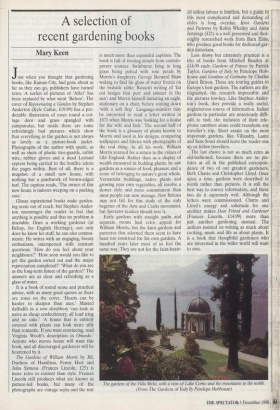A selection of recent gardening books
Mary Keen
Just when you thought that gardening books, like Kansas City, had gone about as far as they can go, publishers have turned retro. A surfeit of pictures of 'After' has been replaced by what went 'Before'. The cover of Rejuvenating a Garden by Stephen Anderton (Kyle Cathie, £19.99) has a pre- dictable illustration of roses round a cot- tage door and grass spangled with campanulas, but inside there are some refreshingly bad pictures which show that everything in the garden is not always as lovely as a picture-book jacket. Photographs of the author with spade, as well as shots of plastic tree-guards, rabbit wire, rubber gloves and a dead Leyland cypress being carried to the bonfire adorn the pages within. Best of all, there is a mugshot of a small new house, with nothing but a patchwork of brown-edged turf. The caption reads, 'The owner of this new house is indoors weeping on a packing case.'
Glossy aspirational books make garden- ing seem out of reach, but Stephen Ander- ton encourages the reader to feel that anything is possible and that no problem is insoluble. Once a working gardener (at Belsay, for English Heritage), not only does he know his stuff, he can also commu- nicate. He writes with an engaging, breezy enthusiasm, interspersed with constant questions: 'How do you feel about your neighbours?' How soon would you like to get the garden sorted out and the major rejuvenation completed?' What do you see as the long-term future of the garden?' The answers are as clear and refreshing as a glass of water.
It is a book of sound sense and practical advice, with as many good quotes as there are roses on the cover. 'Hearts can be harder to sharpen than axes.' Massed daffodils in a new shrubbery 'can look as naive as cheap confectionery, all loud icing and no cake.' A house that is entirely covered with plants can look more silly than romantic. If you want convincing, read Virginia Woolf's description in Orlando.' Anyone who moves house will want this book, and all discouraged gardeners will be heartened by it.
The Gardens of William Morris by Jill, Duchess of Hamilton, Penny Hart and John Symons (Frances Lincoln, £25) is more retro in content than style. Frances Lincoln still produces what are known as picture-led books, but many of the photographs are vintage sepia and the text is much more than expanded captions. The book is full of riveting details from contem- porary sources: Swinburne lying in long grass being pelted with rose petals by Morris's daughters; George Bernard Shaw waking to find his glass of water frozen on the bedside table; Rossetti writing of 'fat cut hedges that purr and simmer in the sun'; and Morris himself imitating an eagle, stationary on a chair, before coming down `with a soft flop'. Language-minders may be interested to read a letter written in 1871 when Morris was 'looking for a house for the wife and kids'. The second half of the book is a glossary of plants known to Morris and used in his designs, comparing wallpapers and fabrics with photographs of the real thing. In all his work, William Morris yearned for a return to the values of Old England. Rather than as a display of wealth measured in bedding plants, he saw gardens as a source of food, pleasure and a sense of belonging to nature's great whole. Vernacular buildings, native plants and growing your own vegetables, all involve a slower style and more commitment than most people can now manage. New Britons may not fall for this study of the only begetter of the Arts and Crafts movement, but Spectator readers should love it.
Early gardens with straight paths and separate rooms had retro appeal for William Morris, but the knot gardens and parterres that adorned them seem to have been too contrived for his own gardens. A hundred years later most of us feel the same way. They are not for the faint-heart- ed unless labour is limitless, but a guide to this most complicated and demanding of styles is long overdue. Knot Gardens and Parterres by Robin Whalley and Anne Jennings (£25) is a well presented and thor- oughly researched work from Barn Elms, who produce good books for dedicated gar- den historians.
Less showy but extremely practical is a trio of books from Mitchell 13eazley at £14.99 each: Gardens of France by Patrick Taylor, Gardens of Italy by Penelope Hob- house and Gardens of Germany by Charles Quest Kitson. These are touring guides to Europe's best gardens. The authors are dis- tinguished, the research impeccable and the pictures low-key. Like Stephen Ander- ton's book, they provide a really useful, unglamorous source of information. Italian gardens in particular are notoriously diffi- cult to visit; the inclusion of their tele- phone numbers alone could transform any traveller's trip. Short essays on the most important gardens, like Villandry, Lante and Sans Souci should leave the reader one up on fellow travellers.
The last choice is not so much retro as old-fashioned, because there are no pic- tures at all in the published correspon- dence of two of our greatest gardeners, Beth Chatto and Christopher Lloyd. Once upon a time, gardens were described in words rather than pictures. It is still the best way to convey information, and these two do it supremely well. Although the letters were commissioned, Chatto and Lloyd's energy and solicitude for one another makes Dear Friend and Gardener (Frances Lincoln, £14.99) more than just another gardening manual. The authors insisted on writing as much about cooking, music and life as about plants. It is a book that thoughtful gardeners who are interested in the wider world will want to own.
The gardens of the Villa Melzi, with a view of Lake Como and the mountains to the north. (From The Gardens of Italy by Penelope Hobhouse)


















































































 Previous page
Previous page